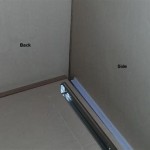```html
How To Arrange A Kitchen Cupboard: A Comprehensive Guide
Maintaining an organized kitchen cupboard is essential for efficient meal preparation, reduced food waste, and an overall more pleasant cooking experience. A well-arranged cupboard saves time and effort by making it easy to locate needed ingredients and tools. This article provides a detailed guide to effectively organizing a kitchen cupboard.
Assessing and Preparing for Organization
Before initiating the organization process, a thorough assessment of the current cupboard contents and layout is necessary. This evaluation identifies existing organizational challenges and informs the subsequent arrangement strategy. The first step is to completely empty the cupboard. This provides a clear view of the available space and allows for a comprehensive cleaning.
Once emptied, the cupboard should be thoroughly cleaned. Wipe down all surfaces with a damp cloth and a mild cleaning solution. This removes accumulated dust, grime, and food debris. Allow the cupboard to dry completely before replacing any items. Inspect the cupboard for any signs of damage, such as loose shelves or peeling paint. Address any necessary repairs before proceeding with the organization process.
Inventory all items removed from the cupboard. This includes canned goods, dry goods, spices, cookware, and any other kitchen essentials stored within. Discard any expired or unwanted items. Check expiration dates on all food products and dispose of anything that is past its prime. This prevents the use of spoiled ingredients and frees up valuable cupboard space. Consider donating unopened, non-perishable items that are no longer needed. Reducing clutter is a critical first step in establishing an organized cupboard.
Categorize the remaining items based on their function or usage. Common categories include baking supplies, breakfast items, snacks, canned goods, spices, and cookware. This categorization will guide the placement of items back into the cupboard, ensuring that similar items are stored together. This facilitates easy access and streamlines meal preparation. Grouping items by function eliminates unnecessary searching and promotes a more efficient kitchen environment.
Measure the dimensions of the cupboard space, including the height, width, and depth of each shelf. This information will be crucial for selecting appropriate storage containers and organizers. Knowing the exact dimensions prevents the purchase of items that are too large or too small for the available space. Consider the height of items that will be stored on each shelf when determining shelf placement. Adjustable shelves offer flexibility in accommodating items of varying sizes.
Implementing Effective Organizational Strategies
After the initial assessment and preparation, the next step is to implement effective organizational strategies. This involves selecting appropriate storage containers, optimizing shelf space, and establishing a logical arrangement system. Clear storage containers are highly recommended for storing dry goods such as flour, sugar, pasta, and cereals. These containers allow for easy identification of contents and help to maintain freshness by creating an airtight seal. Choose containers that are stackable to maximize vertical space within the cupboard.
Label all storage containers clearly with the contents and expiration date, if applicable. This eliminates guesswork and ensures that items are used before they expire. Use a consistent labeling system for a visually appealing and easily navigable cupboard. Consider using a label maker for a professional and uniform appearance. Consistent labeling reinforces the organization system and promotes long-term maintenance.
Optimize shelf space by utilizing shelf dividers or risers. These tools create additional vertical space and prevent items from being stacked haphazardly. Shelf dividers are particularly useful for organizing plates, bowls, and cutting boards. Risers elevate items, making them more visible and accessible. These simple additions can significantly increase the storage capacity of a cupboard.
Consider using lazy Susans or turntables, especially for organizing spices, condiments, or canned goods. These rotating platforms allow for easy access to items stored at the back of the cupboard. This prevents items from being forgotten and ensures that they are used before they expire. Lazy Susans are particularly effective in corner cupboards or other hard-to-reach areas.
Store frequently used items in easily accessible locations. Items that are used daily or weekly should be placed at eye level or within easy reach. Less frequently used items can be stored on higher or lower shelves. This arrangement maximizes efficiency and minimizes the time spent searching for needed items. Prioritize accessibility based on usage frequency.
Utilize the door space of the cupboard by installing spice racks or hooks. These organizers provide additional storage space and can be particularly useful for small items. Spice racks keep spices organized and easily accessible. Hooks can be used to hang measuring cups, utensils, or pot holders. Utilizing door space maximizes the overall storage capacity of the cupboard.
Maintaining and Refining Cupboard Organization
Once the cupboard is organized, it is crucial to establish a maintenance routine to prevent clutter from accumulating. Regular maintenance ensures that the organization system remains effective and prevents the cupboard from reverting to its previous state of disarray. Conduct a quick inventory of the cupboard contents on a weekly basis. This allows for the identification of any items that are nearing their expiration date or that are no longer needed. Discard or donate these items promptly to prevent clutter.
Restock items as needed, ensuring that new items are placed in their designated locations. Avoid simply shoving new items into the cupboard without regard to the existing organization system. This reinforces the established order and prevents clutter from accumulating. Make it a habit to put items away immediately after use.
Periodically review and adjust the organization system as needed. As dietary habits and cooking preferences change, the contents of the cupboard may also need to be adjusted. Re-evaluate the placement of items and the effectiveness of the storage containers. Make any necessary adjustments to optimize the organization system. Flexibility is key to maintaining a well-organized cupboard over time.
Consider implementing a "one in, one out" rule. For every new item that is added to the cupboard, an existing item should be removed. This prevents overcrowding and ensures that the cupboard remains manageable. This rule encourages mindful purchasing and helps to control the accumulation of unnecessary items.
Involve all household members in the organization and maintenance process. Explain the organization system and encourage everyone to follow it. This fosters a sense of shared responsibility and ensures that the cupboard remains organized consistently. Clear communication is essential for maintaining a well-organized kitchen environment.
Deep clean the cupboard at least twice a year. This involves emptying the cupboard completely, cleaning all surfaces, and re-organizing the contents. This provides an opportunity to reassess the organization system and make any necessary adjustments. Regular deep cleaning helps to maintain a hygienic and organized kitchen environment.
Evaluate the effectiveness of the chosen storage solutions. Are the containers the right size and shape? Are the shelf dividers and risers functioning as intended? Make any necessary adjustments to optimize the storage solutions. Investing in high-quality storage solutions can significantly improve the organization and efficiency of the cupboard.
By consistently implementing these strategies, maintaining a well-organized kitchen cupboard becomes a manageable and rewarding task, contributing to a more efficient and enjoyable cooking experience.
```
How To Organize Your Kitchen Cabinets In 3 Simple Steps Practical Perfection

How To Organize Your Kitchen Cabinets And Pantry Feed Me Phoebe

Simple And Affordable Tips To Organize Your Kitchen Cabinets

Best Way To Organize Kitchen Cabinets Step By Project The Container

How To Organize Kitchen Cabinets In 9 Simple Steps Trusted Since 1922

How To Organize Kitchen Cabinets Clean And Scentsible Cabinet Organization

How To Organize Kitchen Cabinets And Drawers For Good

40 Best Ideas For How To Organize Kitchen Cabinets

Organize Your Kitchen Cabinets Using These Easy Tips Hsa

40 Best Ideas For How To Organize Kitchen Cabinets
Related Posts








